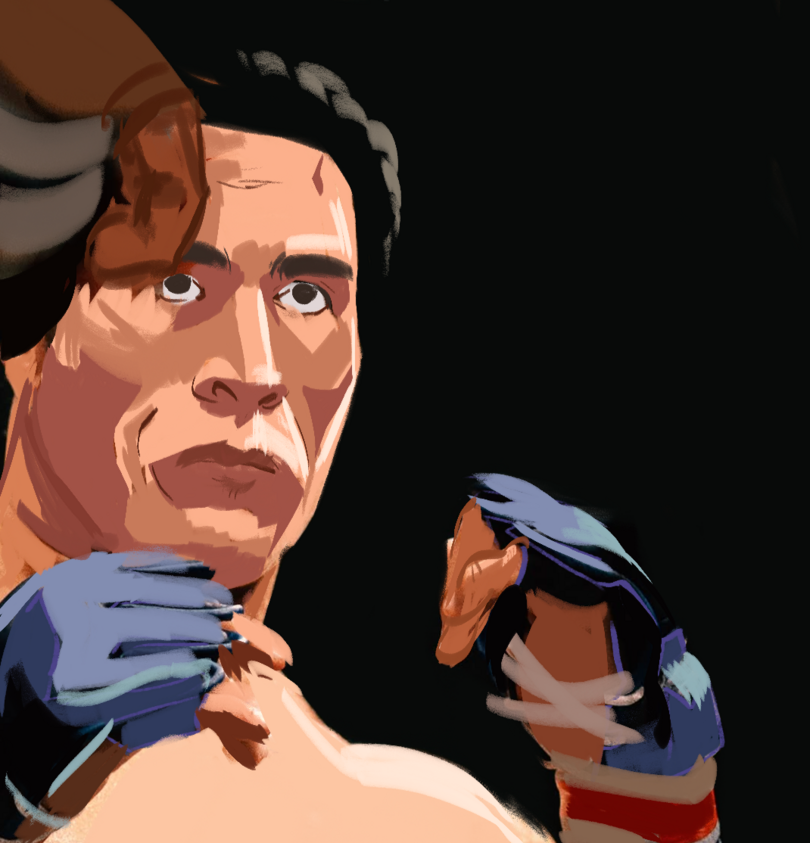Based on SU wrestling alum, ‘The Smashing Machine’ right hooks UFC authenticity

"The Smashing Machine" may be Dwayne "The Rock" Johnson's best ever performance, our columnist says. Even Mark Kerr's family members were impressed with the authenticity of his portrayal of the UFC fighter. Julia Rodenberger | Contributing Illustrator
Get the latest Syracuse news delivered right to your inbox.
Subscribe to our newsletter here.
Editor’s note: This article includes mention of violence and suicide.
They say history is written by the victors. For Mark Kerr, that has certainly seemed true. Despite winning two heavyweight tournaments in the 1990s and a winning record, stacked losses toward the end of his career have kept Kerr from becoming as mainstream as modern MMA fighters like Conor McGregor or Jon Jones.
However, that all may change after Benny Safdie’s solo directorial debut, “The Smashing Machine,” a biopic which highlights Kerr’s (Dwayne Johnson) early MMA career.
A24’s “The Smashing Machine” follows Kerr’s MMA stint from 1997 to 2000. The film covers his highest peaks, like winning a UFC title, and lowest valleys, like abusing opioids. While fights in the ring are pivotal to the story, the film centers around battles with his significant other, Dawn Staples (Emily Blunt). Combining this authentic, character-driven approach with memorable lead performances makes “The Smashing Machine” truly great.
Before the events of the film, real-life Kerr wrestled for Syracuse University, though his journey was tumultuous.
In May 1989, Kerr was arrested for stealing another student’s stereo equipment. He lost his athletic scholarship and was kicked out of SU. Kerr received a year of probation and enrolled at Onondaga Community College.
Eventually, he earned back his scholarship and returned to SU. Kerr won a national championship for SU (defeating Randy Couture) and became an All-American at 190 pounds before graduating in 1992. He competed in the 1996 Olympic qualifying but missed out on the games after losing to Kurt Angle.
With three to four hours worth of makeup, 21 prosthetics and an added 30 pounds of muscle, an unrecognizable Johnson (also known as “The Rock”) delivers arguably the best performance of his career. Calling it “the most challenging thing I’d ever done,” Johnson was on par with Blunt, who was excellent per usual. Kerr’s son even said he was impressed by the accuracy of Johnson’s portrayal of his dad, according to ESPN.
Johnson — who’s now worthy of his own Oscar nomination — didn’t take any shortcuts in making his portrayal of Kerr as real as possible. He worked with a voice coach to capture Kerr’s surprisingly soft-spoken tone and took a real punch in the face during the film’s final fight. As a WWE professional wrestler, Johnson knows how to handle contact. He even met real-life Kerr in the 90s while both trained at Gold’s Gym in Venice, California.
Johnson showed his range, flipping seamlessly between mild-mannered and enraged. In one scene, Kerr kindly explains the UFC to an older lady in a waiting room; in another, he rips apart a door like it’s cardboard.
The all-around authenticity of “The Smashing Machine” is mesmerizing. Inspired by the 2002 documentary of the same name, Safdie makes you feel like a fly on the wall in Kerr’s life. This can be attributed to cinematographer Maceo Bishop’s engrossing camerawork — my favorite aspect of the movie — even with Johnson’s outstanding performance.
Safdie and Bishop open “The Smashing Machine” with VHS camera footage, before switching to 16 and 65 mm film. It’s the first time a movie has been shot on 16 mm for IMAX — a risky move because of the film’s graininess, but it sure paid off.
By upping the resolution and reducing some of the grain, the texture of the 16 mm sequences capture the quality of a documentary or home video. Bishop adds to the documentary-style feel with nonessential zooms, purposefully unstable shots, hidden cameras and fight scenes filmed from outside the ring.
After Kerr’s second UFC championship, he began competing in the PRIDE Fighting Championships, an MMA company based in Japan, where he didn’t do too well. When recreating those matches, Safdie used the same types of cameras that PRIDE FC had.
Real martial artists were cast as his coach and fellow fighters, including Yoko Hamamura — who punched Johnson — and Ryan Bader, who, despite not having acting experience, delivered the best performance outside of Johnson and Blunt. These details fill “The Smashing Machine” with supreme levels of authenticity and are a true testament to Safdie’s dedication.
Like Kerr, Nala Sinephro’s first film score is often calm, filled with soothing jazz, but becomes ferocious when it needs to. Sinephro includes traditional jazz instruments and more modern-sounding synths. A standout is the title track, which has strong drums that accompany a fight sequence. The soundtrack features fitting song choices, headlined by a live rendition of “My Way” by Elvis Presley.
While the acting in “The Smashing Machine” is incredible, my major complaint is that the events of Kerr and Staples’ relationship don’t feel cohesive. The scenes by themselves work super well, but together, don’t add anything. They’re just serial episodes of them getting back together and then arguing. Even if that’s the truth about their relationship, the events, which take place over three years, didn’t completely intertwine in the film.
The film’s epilogue features a scene of the real Kerr. On-screen text details the events of Kerr’s life after the film’s timeline. Instead of providing closure, the information is vague and confusing, leaving me with unnecessary questions.
The film has a patient, character-driven approach — reminiscent of “Rocky” — focusing on Kerr’s human nature rather than portraying him as simply a figure in the ring. The most intense moment doesn’t involve MMA; it’s an argument between Staples and Kerr that escalates into Staples’ suicide attempt.
Staples is upset over Kerr’s prioritization of his match, but Kerr breaks down a door, stopping her attempt. The emotional scene highlights Johnson and Blunt’s tense dynamic and remarkable performances.
With excellent cinematography, an effective soundtrack and high-quality acting from the “Jungle Cruise” co-stars, “The Smashing Machine” lands a powerful right hook. Despite a poor outing at the box office, Safdie’s authentic look at the life of a 2025 UFC Hall of Famer is one of the best movies of the year.






